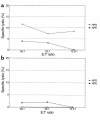Late seroconversion in HIV-resistant Nairobi prostitutes despite pre-existing HIV-specific CD8+ responses
- PMID: 11160158
- PMCID: PMC199193
- DOI: 10.1172/JCI10714
Late seroconversion in HIV-resistant Nairobi prostitutes despite pre-existing HIV-specific CD8+ responses
Abstract
Resistance to HIV infection in a small group of Kenyan sex workers is associated with CD8+-lymphocyte responses to HIV cytotoxic T-lymphocyte (CTL) epitopes. Eleven prostitutes meeting criteria for HIV resistance seroconverted between 1996 and 1999. The occurrence and specificity of preexisting HIV-1 epitope-specific responses were examined using the IFN-gamma enzyme-linked immunospot assay, and any epitopes recognized were cloned and sequenced from the infecting viral isolate. Immunologic and behavioral variables were compared between late seroconverters and persistently uninfected sex worker controls. HIV-1 CTL epitope responses were present in four of six cases, 5-18 months before seroconversion, and their presence was confirmed by bulk CTL culture. A possible viral escape mutation was found in one of six epitopes. The key epidemiologic correlate of late seroconversion was a reduction in sex work over the preceding year. In persistently uninfected controls, a break from sex work was associated with a loss of HIV-specific CD8+ responses. Late seroconversion may occur in HIV-1-resistant sex workers despite preceding HIV-specific CD8+ responses. Seroconversion generally occurs in the absence of detectable CTL escape mutations and may relate to the waning of HIV-specific CD8+ responses due to reduced antigenic exposure.
Figures



Comment on
-
HIV versus the immune system: another apparent victory for the virus.J Clin Invest. 2001 Feb;107(3):273-5. doi: 10.1172/JCI12174. J Clin Invest. 2001. PMID: 11160150 Free PMC article. No abstract available.
References
-
- Clerici M, Shearer GM. Correlates of protection in HIV infection and the progression of HIV infection to AIDS. Immunol Lett. 1996; 51:69–73. - PubMed
-
- Haynes BF, Pantaleo G, Fauci AS. Toward an understanding of the correlates of protective immunity to HIV infection. Science. 1996; 271:324–328. - PubMed
-
- Rowland-Jones SL, McMichael A. Immune responses in HIV-exposed seronegatives: have they repelled the virus? Curr Opin Immunol. 1995; 7:448–455. - PubMed
-
- Letvin NL. Progress in the development of an HIV-1 vaccine. Science. 1998; 280:1875–1880. - PubMed
Publication types
MeSH terms
Substances
LinkOut - more resources
Full Text Sources
Research Materials

